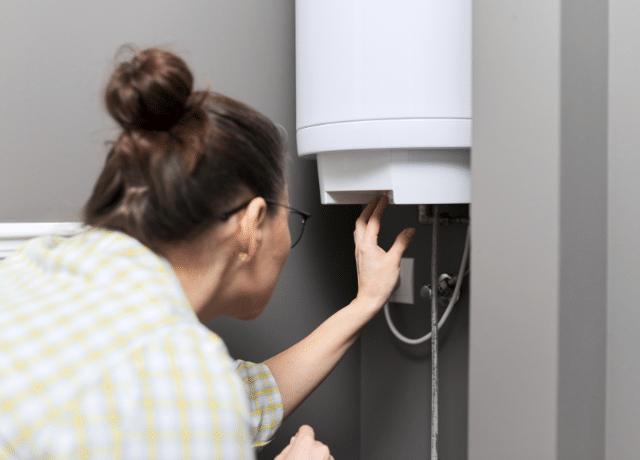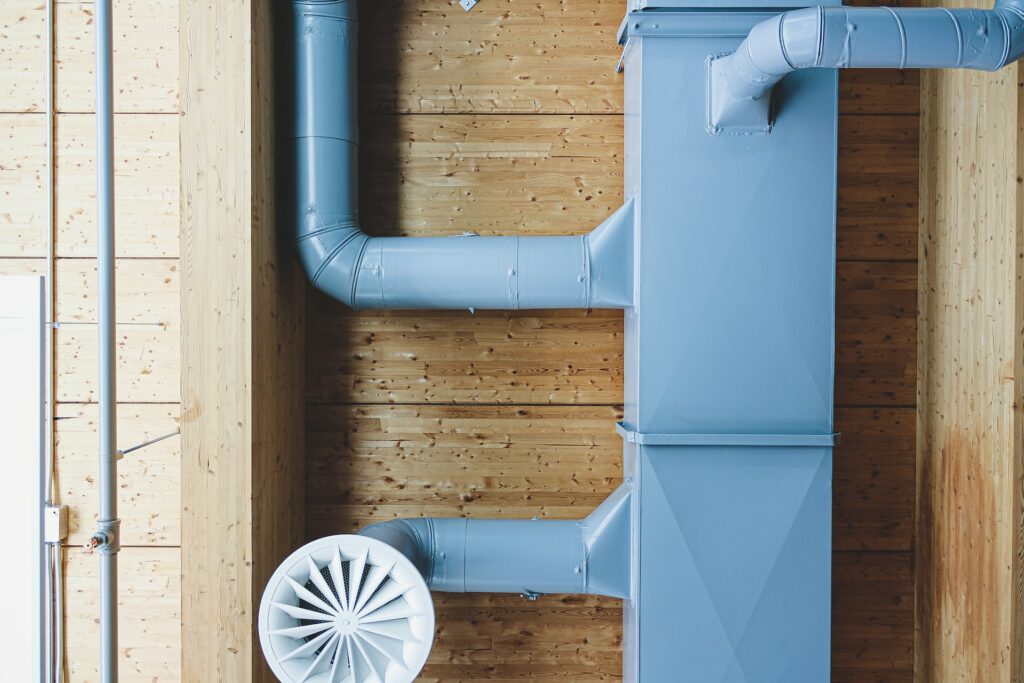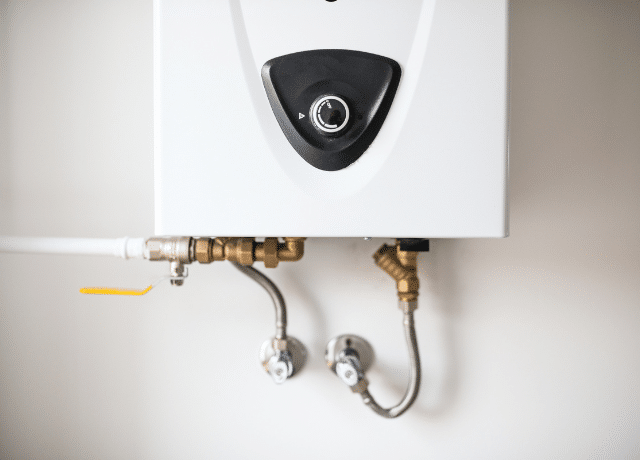Introduction – Tanked vs Tankless
Briefly speaking, given a modest flow-rate requirement and temperature differential heating, we calculate that an electric tankless water heater would need about 30 kW which is substantial. Heating water, along with heating space, makes up the top two biggest uses of electricity in a house. The traditional way to heat water, popular in the last 50 years, is to store water in a large tank and have the furnace maintain its temperature so hot water is ready to be used.
Tankless water heaters are a new take over traditional water heaters. Tankless water heaters are compact, taking up less space than their traditional counterparts. This is especially important in smaller homes and apartments, which may not have enough room to accommodate a large water heater.

Below we will tell you about the wattage, how to select one and also how to calculate the flow rate requirement given all your faucets and water use devices.
Because they don’t have a tank, tankless water heaters overall use less energy than traditional models. This is because they only burn fuel when hot water is needed, rather than continuously heating gallons of water that don’t get used.
Tankless water heaters use lots of electricity, so you’ll need to consider how your home uses electricity before buying a tankless water heater. Many homes use an electric heat pump, which doesn’t work well with tankless models. Other homes use gas for heating and cooking, so a tankless water heater will be perfect.
What Is The Average Tankless Water Heater Wattage?
We calculate the average tankless water heater uses 6387-kilowatt hours (kWh) of electricity per year. To calculate this, consider that an average family uses the equivalent of 35 min of hot water per day, which accounts for total showers and hand washing, and use by appliances that draw on hot water. For a medium powered tankless water heater that draws 30 kW (kilowatt hours) as we calculate below, over a year that would be 35 min per day x 15 kW x 365 days = 212 hours, or 6387 kWh per year.
Generally speaking, a tankless water heater is a substantial electrical load and many homes will not have sufficient electrical service to handle this along with the home’s other electrical loads. A unit of this size would require around 170 amps at 240 volts, which is near or beyond the total service capacity of many homes. A central heating HVAC powered by electricity is rated 15-20 kW already.
This illustrates one of the challenges with electric tankless water heaters. While smaller units (around 15-20 kW) may be suitable for servicing a single fixture or small apartment, larger applications often require gas tankless heaters, or multiple electric units.
Deviations on this average are due to your water usage patterns, the size and efficiency of the unit, and the climate in which it is being used. However, a tankless model can save 10-20% in energy costs annually compared to a traditional tank water heater.
Now, average household use of electricity is close to 10,000 kWh per year. Tankless water heaters would then take up extra electricity of 30% on top of this energy usage! You will save money on the traditional water heating. Only space heating and cooling use more energy than this.
Additionally, a tankless water heater provides an endless hot water supply, only heating water as needed. This means no standby energy loss is associated with keeping a large tank of hot water constantly heated. Switching to a tankless water heater can have numerous benefits for your wallet and the environment.
What Is A Tankless Water Heater, And How Does It Work?

A tankless water heater is a type of water heating system that does not rely on a storage tank to heat water. It is instead powered by an on-demand or demand-type system, making it much more efficient than traditional storage tank water heaters. Instead of continuously heating and storing a certain amount of water, a tankless water heater heats water only when it is needed. This not only saves energy but also allows for an endless supply of hot water.
So how does it work? A tankless water heater has one or more heating units, either gas or electric, connected to the home’s water source. As cold water enters the unit, it passes through a series of heat exchangers, raising the temperature to the desired level. This process happens instantaneously, allowing for hot water on demand.
Tankless water heaters can save homeowners money over time through their energy efficiency and reduced use of storage space. However, they require regular maintenance and may have higher initial installation costs than traditional models. Whether you choose a tankless system or stick with a storage tank model, opting for an Energy Star-certified unit can significantly increase efficiency and decrease monthly expenses.
The Benefits Of Tankless Water Heaters Over Traditional Water Heaters
The switch to a tankless water heater can bring many benefits to your home. First, they can save you money in the long run. Tankless models heat water on demand rather than continuously heating and storing it in a tank. This means less energy is wasted, and your monthly utility bills can decrease.
Additionally, tankless water heaters take up much less space as they don’t have a bulky storage tank. This allows for greater design flexibility in the layout of your home. The lack of a storage tank also means there’s no risk of leaking or potential flooding.
Lastly, tankless water heaters have longer lifespans than traditional models and often come with extended warranties for added peace of mind. The switch to a tankless water heater may require an initial investment, but the long-term benefits make it well worth it.
Sizing A Tankless Water Heater
Sizing a tankless water heater for your home is not a one-size-fits-all process. You’ll need to consider factors like the number of bathrooms in your house, how often you plan to run hot water simultaneously, the climate and elevation of your location, and the temperature rise necessary to achieve your desired hot water output.
Start by determining the maximum flow rate required for your household’s hot water needs. This can be calculated by adding up the flow rate requirements for each potential simultaneous hot water use (such as shower heads, faucets, dishwashers, etc.). Next, consider any potential temperature rise needed – for example, if you have elevations above 6,500 feet or live in a colder climate, you may need a higher temperature rise to reach the desired hot water output. And finally, make sure the tankless water heater you choose has a maximum flow rate that meets or exceeds your calculations.
Calculate The Flow Rate – Step-By-Step
(06/01/2023 note: error in step 3 was noted and corrected below)
- Calculate the Total Flow Rate Required for Your Home: Identify the plumbing fixtures you expect to use simultaneously and add up their flow rates, which are typically measured in gallons per minute (GPM). For instance, if you have a shower head with a flow rate of 2.5 GPM and a sink with a flow rate of 0.5 GPM, the total flow rate would be 3 GPM.
- Determine the Temperature Rise Needed: Calculate the difference between your incoming water temperature and the temperature you want the water to be. This is your temperature rise. For example, if your incoming water is 50°F and you want your hot water to be 120°F, your temperature rise would be 70°F.
- Calculate the Energy Requirement: Use the following formula to calculate the energy requirement in BTU/hr (British Thermal Units per hour):BTU/hr = Flow rate (GPM) x Temperature rise (°F) x 500For example, if your total flow rate is 3 GPM and your temperature rise is 70°F, then your BTU/hr requirement would be:BTU/hr = 3 GPM x 70°F x 500 = 105,000 BTU/hr
- Convert Energy Requirement to Watts: To convert the BTU/hr requirement to watts, use the conversion factor of 1 Watt = 3.412142 BTU/hr. For example, 105,000 BTU/hr is equivalent to approximately 30,769 watts (or 30.8 kilowatts).
- Consider Your Home’s Electrical System Capacity: Typical residential electrical systems in the United States might only provide between 100-200 amps of service, and not all of this is available for a single application like a tankless water heater. A heater requiring 30 kilowatts would require a substantial amount of electrical power. Make sure to consult with a qualified electrician to determine if your home’s electrical system can support your anticipated hot water demand.
It’s always better to err on the side of caution and go with a larger unit than necessary rather than end up with insufficient hot water capability. The process might seem daunting at first, but with careful consideration of these factors and potentially consulting a professional installer, you can find the perfect fit tankless water heater for your home’s needs.

What Factors Affect The Wattage Of A Tankless Water Heater?
There are several factors that can affect the wattage of a tankless water heater, including the type and size of the unit, as well as its operating environment. Some key factors to consider include the following:
- The flow rate required for your household’s hot water needs. This can depend on various factors, such as the number of bathrooms and appliances in your home or how many people are typically using hot water simultaneously.
- The temperature rise is needed to achieve your desired output. Colder climates may require higher temperature rises than warmer ones, while elevations above 6500 feet may also impact the operation and require increased wattage.
- The size and material of the heat exchanger and other components in the unit. Larger and more robust components may require more wattage to operate efficiently.
Overall, there is no one-size-fits-all approach to determining the wattage of a tankless water heater, and careful consideration of all these factors will help you select the right model for your home’s needs.
How To Find The Right Tankless Water Heater For Your Needs?
How many bathrooms do you have? How much hot water do you typically use at one time? How often do you need hot water? Once you know your requirements, you can start looking at specific models and features.
Look for energy efficiency ratings and the heater’s maximum hot water capacity and flow rate. Consider the size and installation options – will it fit in your designated space, and is it easy to install? Be sure to factor in costs, including additional materials or professional installation fees.
By taking the time to consider all of these factors, you’ll be able to find a tankless water heater that meets your individual needs and provides efficient, reliable hot water for years to come. Three brands that are worth considering are given here:
- Rinnai: Rinnai is a leading brand in the tankless water heater industry. They offer a variety of models that cater to both residential and commercial needs. Known for their quality and reliability, Rinnai’s tankless water heaters are energy-efficient and equipped with advanced temperature control features.
- Navien: Navien is a highly reputable brand known for its condensing tankless water heaters, which are designed to be highly energy efficient. Their models often come with built-in recirculation systems, reducing water waste and providing hot water quickly.
- Rheem: A well-known brand in the water heater market, Rheem offers both tanked and tankless water heaters. Rheem’s tankless water heaters are praised for their high-quality, durability, and advanced features like Wi-Fi connectivity for remote control and monitoring.
Wrapping Up
In conclusion, there are many factors to consider when selecting the right tankless water heater for your needs. Some key considerations include the flow rate required, the temperature rise necessary, and the size and material of key components in the unit. Additionally, it is important to look at energy efficiency ratings, installation options, cost, and other factors that can impact performance. By carefully considering all these factors, you can find a tankless water heater that meets your needs and provides reliable hot water for your home.
